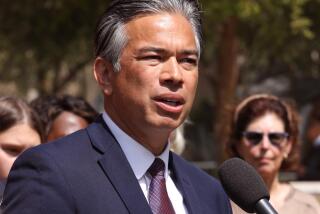U.S. Pursues Major Land Swap in Mojave
- Share via
Federal officials are working to acquire $100 million worth of private land in the Mojave Desert to expedite the controversial expansion of the U.S. Army’s tank training center at Ft. Irwin and at the same time rescue thousands of acres of wilderness from threatened development.
The deal follows other efforts by U.S. Interior Secretary Bruce Babbitt to broker land swaps to protect natural resources in Yellowstone National Park and Northern California’s Headwaters Forest.
The “mega-deal” in the California desert, as it is being described by Department of Interior officials, would allow Ft. Irwin to expand southward instead of eastward, where it faces opposition from an array of environmentalists, off-road vehicle enthusiasts, hunters, prospectors and local governments.
The base wants 331,000 more acres for tank maneuvers.
Under the latest proposal, the Department of Interior would be able to extend its jurisdiction over fragile land in the western Mojave and in the Mojave National Preserve. The deal would allow the preserve to acquire land within its confines that could be developed if it remains in private hands.
In return, the current owner of the privately held desert real estate, Catellus Development Corp., would be offered cash or replacement land elsewhere, possibly at one of the nation’s surplus military bases.
The exchange would cure two big headaches for the federal government--accommodating Ft. Irwin, which has been looking for growing room for several years, and complying with all of the provisions of the 1994 California Desert Protection Act. The act created the Mojave Preserve and called for stricter government stewardship of millions of acres of ecologically valuable desert near the preserve.
“To do a mega-deal of these proportions would be of great significance,” said Deputy Interior Secretary John Garamendi, “especially if we could get Catellus out of the park.”
Catellus is analyzing mineral resources and development potential on the 285,000 acres that it owns inside the preserve. In all, the company, which is the former real estate arm of the Southern Pacific Railroad, owns 800,000 acres of desert land in California.
But commercial development of remote lands inside a national park could be costly, time-consuming and extremely unpopular. And Catellus officials have indicated that they are open to a government buyout.
“Catellus has long been interested in facilitating the acquisition by the federal government of lands encompassed by the Desert Protection Act. We want to cooperate to the extent it is economically feasible,” said a company statement released Tuesday.
Garamendi declined to identify any government assets that might be offered in return for Catellus land.
Ft. Irwin officials did not respond Tuesday when asked for their reaction to the land swap proposal.
But spokesmen for major environmental groups continued to express opposition to any plans for Ft. Irwin’s expansion.
The Sierra Club this week disclosed the results of a study it co-sponsored that says Ft. Irwin already is the largest generator of particulate-matter air pollution in California and one of the 10 biggest sources in the country. According to the study, the base is responsible for more than 28,000 tons a year of PM-10, microscopic dust particles that can cause respiratory ailments.
“Expansion would only kick up a whole lot more dust,” said Eldon Hughes, who chairs the Sierra Club’s California desert committee. “Up to now, the Army has failed to show a compelling reason for expanding Ft. Irwin.”
Spokesmen for both the Sierra Club and the Wilderness Society expressed additional reservations about southward expansion of the base, saying it would jeopardize important habitat of the endangered desert tortoise.
“Some of the best, high-density habitat around is out there, in the mountains south of Ft. Irwin,” said Norbert Riedy, California conservation director of the Wilderness Society. “It would have to be a land swap of enormous proportions to make up for those losses.”
Addressing that issue, Garamendi said the deal would have to include enough Catellus land to offset any of the habitat imperiled by military maneuvers to the south of Ft. Irwin.
“Success depends on what we can obtain elsewhere--in the west or east Mojave--for the benefit of the tortoise,” Garamendi said.
On that issue, Garamendi must forge a consensus among competing interests within his own department. On one hand, the U.S. Bureau of Land Management is interested mainly in gaining control of Catellus lands in the west Mojave.
Park service officials fear that they are being excluded from discussions of the proposed deal with Catellus.
“The National Park Service has not been included in any talks. I have not been consulted and that concerns me,” said Mary Martin, superintendent of the Mojave Preserve.
More to Read
Sign up for Essential California
The most important California stories and recommendations in your inbox every morning.
You may occasionally receive promotional content from the Los Angeles Times.










